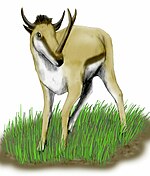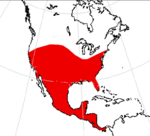| Protoceratids Temporal range: Middle Eocene–Early Pliocene PreꞒ Ꞓ O S D C P T J K Pg N | |
|---|---|

| |
| Synthetoceras | |
| Scientific classification | |
| Domain: | Eukaryota |
| Kingdom: | Animalia |
| Phylum: | Chordata |
| Class: | Mammalia |
| Order: | Artiodactyla |
| Family: | †Protoceratidae |
| Subfamilies, Tribes and Genera | |

| |
| Range of Protoceratidae based on fossil record. | |
Protoceratidae is an extinct family of herbivorous North American artiodactyls (even-toed ungulates) that lived during the Eocene through Pliocene. While early members of the group were hornless, in later members males developed elaborate cranial ornamentation. They are variously allied with Ruminantia or Tylopoda.
Classification
Protoceratidae was erected by Othniel Charles Marsh in 1891, with the type genus Protoceras and assigned to the Artiodactyla. It was later assigned to Pecora, and more recently to Ruminantia or Tylopoda. However, recently a relationship to chevrotains in the infraorder Tragulina has been proposed.
Morphology
When alive, protoceratids would have resembled deer, though they were not directly related. Protoceratids ranged from 1 to 2 m in length, from about the size of a roe deer to an elk. Unlike many modern ungulates, they lacked cannon bones in their legs. Their dentition was similar to that of modern deer and cattle, suggesting they fed on tough grasses and similar foods, with a complex stomach similar to that of camels. At least some forms are believed to have lived in herds.
The most dramatic feature of the protoceratids, however, were the horns of the males. In addition to having horns in the more usual place, protoceratids had additional, rostral horns above their noses. These horns were either paired, as in Syndyoceras, or fused at the base, and branching into two near the tip, as in Synthetoceras. In life, the horns were probably covered with skin, much like the ossicones of a giraffe. The females were either hornless, or had far smaller horns than the males. Horns were therefore probably used in sexual display or competition for mates. In later forms, the horns were large enough to have been used in sparring between males, much as with the antlers of some modern deer.
Genera by epoch
Eocene
Oligocene
Miocene
Pliocene
References
- Prothero, D.R. (1998). "Protoceratidae". In Janis, C.M.; Scott, K.M.; Jacobs, L.L. (eds.). Evolution of Tertiary mammals of North America. Cambridge: Cambridge University Press. pp. 431–438. ISBN 0-521-35519-2.
- Robson, Selina Viktor; Seale, Brendon; Theodor, Jessica M. (2021-07-29). Louys, Julien (ed.). "The petrosal and basicranial morphology of Protoceras celer". PLOS ONE. 16 (7): e0251832. doi:10.1371/journal.pone.0251832. ISSN 1932-6203. PMC 8321106. PMID 34324518.
- O. C. Marsh. 1891. A horned artiodactyle (Protoceras celer) from the Miocene. The American Journal of Science and Arts, series 3 41(241):81-82
- S. D. Webb, B. L. Beatty, and G. Poinar, Jr. 2003. New evidence of Miocene Protoceratidae including a new species from Chiapas, Mexico. Bulletin of the American Museum of Natural History 279:348-367
- D. R. Prothero and J. A. Ludtke. 2007. Family Protoceratidae. in D. R. Prothero and S. Foss (eds.), The Evolution of Artiodactyls 169-176
- H. J. Cook. 1934. New artiodactyls from the Oligocene and Lower Miocene of Nebraska. American Midland Naturalist 15(2):148-165
- Thurmond and Jones (1981)
- ^ Spaulding, Michelle; O'Leary, Maureen A.; Gatesy, John (2009). "Relationships of Cetacea (Artiodactyla) among mammals: increased taxon sampling alters interpretations of key fossils and character evolution". PLOS ONE. 4 (9): e7062. Bibcode:2009PLoSO...4.7062S. doi:10.1371/journal.pone.0007062. PMC 2740860. PMID 19774069.
- Carroll and by Webb et al., 2003
- Palmer, D., ed. (1999). The Marshall Illustrated Encyclopedia of Dinosaurs and Prehistoric Animals. London: Marshall Editions. pp. 272–273. ISBN 1-84028-152-9.
- Savage, RJG & Long, MR (1986). Mammal Evolution: an illustrated guide. New York: Facts on File. pp. 222–225. ISBN 0-8160-1194-X.
| Taxon identifiers | |
|---|---|
| Protoceratidae | |